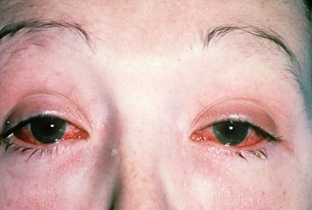Dryness of the mucosa in Sjögren's disease interferes not only with the normal process of blinking or swallowing, but also with the functioning of the gastrointestinal tract, the respiratory system, and other organs. In some cases, Sjögren's disease causes muscle damage, disrupts the functioning of the kidneys, the patient complains of problems with blood vessels, joints, and experiences pain during intercourse. All these manifestations of Sjögren's disease greatly impair the patient's quality of life and require measures to alleviate his condition. Timely treatment contributes to the preservation of the working capacity of patients and slows down the progression of the disease.
Why does Sjögren's disease develop and how does it manifest?
Sjögren's disease refers to an autoimmune disease in which systemic connective tissue damage occurs. It is assumed that the cause that provokes the onset of the disease can be a rotavirus infection. Under the influence of the virus, an autoimmune reaction develops, in which antibodies are formed to one's own connective tissue and lymphoplasmic infiltration of the ducts of most endocrine glands occurs.
Most annoying the problem for a patient with Sjögren's disease is a disruption in the functioning of the glands that secrete tears, saliva, and some other fluids, without which dryness of the mucous membranes occurs. Patients complain of burning and itching in the eyes, reddened eyelids, a viscous secret in the corners of the eyes, narrowing of the palpebral fissure are objectively observed.
Many patients have an increase in paired parotid salivary glands, dry mouth with the appearance of jamming in the corners of the lips, manifestations of stomatitis and multiple caries. Dryness of the mucous membranes in the mouth is manifested by its bright pink color, cracks in the tongue, viscous saliva. With the progression of the disease, it becomes difficult for the patient to swallow and speak, the lips crack, and keratinization is observed in some parts of the oral mucosa.
Dryness of mucous membranes causes dryness of the vulva and vagina, nasopharynx, problems with mucous membranes lead to the development of tracheitis, atrophic bronchitis, and other diseases. Vascular problems in Sjögren's disease may be accompanied by a hemorrhagic rash on the extremities. Patients complain of myositis, polyarthralgia, enlarged lymph nodes.
Stages of manifestation of Sjögren's disease in patients
Taking into account the symptoms, one can distinguish between subacute and chronic forms of Sjögren's disease, its initial, more pronounced and late stages – it all depends on the degree of inflammatory activity. So, in the early stages, disturbances in the work of the salivary, lacrimal glands, and gastric secretion glands predominate. Later, these symptoms are less disturbing, but destructive processes begin in the epithelial glands. In the later stages, Sjögren's disease is manifested by mumps, stomatitis, arthritis, an increase in the liver and spleen, and lymphadenopathy.

Treatment of Sjögren's disease and possible prognosis
Therapy for Sjogren's disease is carried out with a combination of corticosteroids and cytostatic drugs, if necessary, the course of treatment is supplemented with plasmapheresis. Symptomatic therapy consists in eliminating dryness of the mucous membranes, preventing the attachment of a bacterial infection. Normalization of salivation is carried out with the help of novocaine blockade, calcium preparations, applications with rosehip oil are recommended.
If the treatment is started in time, it is possible to slow down the progression of the disease and avoid complications that can lead to disability of the patient.







Add a comment